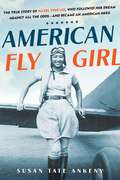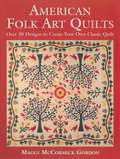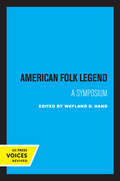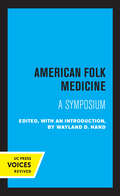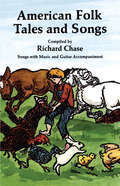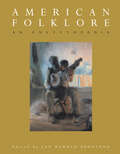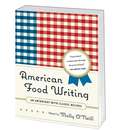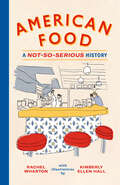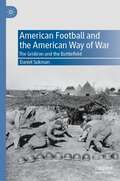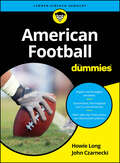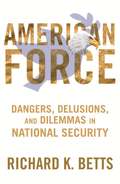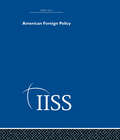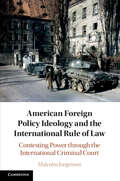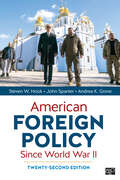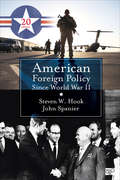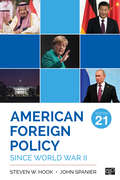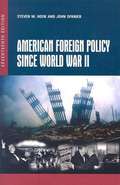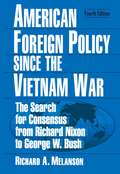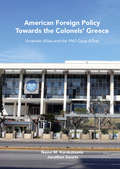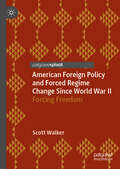- Table View
- List View
American Flygirl
by Susan Tate AnkenyOne of WWII&’s most uniquely hidden figures, Hazel Ying Lee was the first Asian American woman to earn a pilot&’s license, join the WASPs, and fly for the United States military amid widespread anti-Asian sentiment and policies.Her singular story of patriotism, barrier breaking, and fearless sacrifice is told for the first time in full for readers of The Women with Silver Wings by Katherine Sharp Landdeck, A Woman of No Importance by Sonia Purnell, The Last Boat Out of Shanghai by Helen Zia, Facing the Mountain by Daniel James Brown and all Asian American, women&’s and WWII history books. In 1932, Hazel Ying Lee, a nineteen-year-old American daughter of Chinese immigrants, sat in on a friend&’s flight lesson. It changed her life. In less than a year, the girl with the wicked sense of humor, a newfound love of flying, and a tough can-do attitude earned her pilot&’s license and headed for China to help against invading Japanese forces. In time, Hazel would become the first Asian American to fly with the Women Airforce Service Pilots. As thrilling as it may have been, it wasn&’t easy. In America, Hazel felt the oppression and discrimination of the Chinese Exclusion Act. In China&’s field of male-dominated aviation, she was dismissed for being a woman, and for being an American. But in service to her country, Hazel refused to be limited by gender, race, or impossible dreams. Frustrated but undeterred, she forged ahead, married Clifford Louie, a devoted and unconventional husband who cheered his wife on, and gave her all for the cause, achieving more in her short, remarkable life than even she had imagined possible. American Flygirl is the untold account of a spirted fighter and an indomitable hidden figure in American history. She broke through every common belief about women. She challenged every social restriction to endure and to succeed. And against seemingly insurmountable obstacles, Hazel Ying Lee reached for the skies and made her mark as a universal and unsung hero whose time has come.
American Folk Art Quilts: Over 30 Designs to Create Your Own Classic Quilt
by Maggi McCormick GordonA Step-by-Step Guide to Creating Beautiful Quilts! Beautiful antique quilts and a workbook of patterns come together in this lavish photography book for quilters. The more than 30 featured quilts from the Wisconsin State Historical Society collection are displayed in period rooms at Old World Wisconsin, the Society's outdoor museum of German and Scandinavian farmhouses. Patterns and block layouts are provided for replicating each of the original quilts, and after seeing each of them in a true historical context, home sewers will be inspired to create their own versions.
American Folk Art for Kids: With 21 Activities (For Kids series #12)
by Richard PanchykDrawing on the natural folk art tendencies of children, who love to collect buttons, bottle caps, shells, and Popsicle sticks to create beautiful, imperfect art, this activity guide teaches kids about the history of this organic art and offers inspiration for them to create their own masterpieces. The full breadth of American folk art is surveyed, including painting, sculpture, decorative arts, and textiles from the 17th century through today. Making bubblegum wrapper chains, rag dolls, bottle cap sculptures, decoupage boxes, and folk paintings are just a few of the activities designed to bring out the artist in every child. Along the way kids learn about the lives of Americans throughout history and their casual relationships to everyday art as they cut stencils, sew needlepoint samplers, draw calligraphy birds, and design quilts. Important folk artists such as the last surviving Shakers, the legendary Grandma Moses, and the Reverend Howard Finster are also explored in sidebars throughout the book.
American Folk Legend: A Symposium
by Wayland D. HandThis title is part of UC Press's Voices Revived program, which commemorates University of California Press’s mission to seek out and cultivate the brightest minds and give them voice, reach, and impact. Drawing on a backlist dating to 1893, Voices Revived makes high-quality, peer-reviewed scholarship accessible once again using print-on-demand technology. This title was originally published in 1971.
American Folk Medicine: A Symposium
by Donald J. WardThis title is part of UC Press's Voices Revived program, which commemorates University of California Press’s mission to seek out and cultivate the brightest minds and give them voice, reach, and impact. Drawing on a backlist dating to 1893, Voices Revived makes high-quality, peer-reviewed scholarship accessible once again using print-on-demand technology. This title was originally published in 1976.
American Folk Tales and Songs (Dover Books on Music)
by Richard ChaseEver heard the story about the hoe-handle that was bitten by a snake? Or the one about the man in the kraut tub? These and many more tales of wry complexion are included in this collection of uninhibited tales and ballads of the Anglo-American tradition. Collected in the Appalachians, the folklore in this book reflects the hardships, humor, and creative instinct of the robust men and women who have lived in the hills of Carolina, Tennessee, and Kentucky for centuries.Mr. Chase has collected a wide variety of folklore for inclusion in this volume. Here you will find tales of dry humor whose telling will enliven any friendly gathering, or the "jump" tales that literally require the teller to jump at his listener, mostly ghost stories that have enthralled generations of children and grandchildren. Here, complete with guitar chords, are American versions of old English ballads like "The Devil's Questions" and "Bold Robin Hood," and original mountain ballads like "Old Bangum and the Boar." Here too are many hymns and children's songs current in the mountains of the South. A sample of fiddle music and country games can provide inspiration for all manner of parties or family amusements. In addition to the ballads, songs, and stories, Mr. Chase also gives such amusing folk miscellany as riddles, love-rhymes, and jokes. For anyone who seeks a wider familiarity with folk materials, Mr. Chase provides an ample list of suggested further reading and an amateur collector's guide. Notes accompanying each item identify the informant or origin and give details concerning the author's editing "For popular use."American Folk Tales and Songs is meant to be used. The author, one of America's foremost folklorists, has presented his stories and songs so that they can increase the repertory of both storytellers and fireside singers, for folk traditions can live only through the voices and imaginations of those who love good stories and good songs.
American Folklore: An Encyclopedia
by Jan Harold BrunvandContains over 500 articles Ranging over foodways and folksongs, quiltmaking and computer lore, Pecos Bill, Butch Cassidy, and Elvis sightings, more than 500 articles spotlight folk literature, music, and crafts; sports and holidays; tall tales and legendary figures; genres and forms; scholarly approaches and theories; regions and ethnic groups; performers and collectors; writers and scholars; religious beliefs and practices. The alphabetically arranged entries vary from concise definitions to detailed surveys, each accompanied by a brief, up-to-date bibliography.Special features *More than 2000 contributors *Over 500 articles spotlight folk literature, music, crafts, and more *Alphabetically arranged *Entries accompanied by up-to-date bibliographies *Edited by America's best-known folklore authority
American Food Writing: An Anthology with Classic Recipes
by Molly O'NeillIn a groundbreaking new anthology, celebrated food writer Molly O'Neill gathers the very best from over 250 years of American culinary history. This literary feast includes classic accounts of iconic American foods: Henry David Thoreau on the delights of watermelon; Herman Melville, with a mouth-watering chapter on clam chowder; H. L. Mencken on the hot dog; M. F. K. Fisher in praise of the oyster; Ralph Ellison on the irresistible appeal of baked yam; William Styron on Southern fried chicken. American writers abroad, like A. J. Liebling, Waverly Root, and Craig Claiborne, describe the revelations they found in foreign restaurants; travellers to America, including the legendary French gourmet J. A. Brillat-Savarin, discover such native delicacies as turkey, Virginia barbecue, and pumpkin pie. Great chefs and noted critics discuss their culinary philosophies and offer advice on the finer points of technique; home cooks recount disasters and triumphs. A host of eminent American writers, from Nathaniel Hawthorne, Harriet Beecher Stowe, and Walt Whitman to Thomas Wolfe, Willa Cather, and Langston Hughes, add their distinctive viewpoints to the mix.
American Food: A Not-So-Serious History
by Rachel WhartonAn illustrated journey through the lore and little-known history behind ambrosia, Ipswich clams, Buffalo hot wings, and more. This captivating and surprising tour of America’s culinary canon celebrates the variety, charm, and occasionally dubious lore of the foods we love to eat, as well as the under-sung heroes who made them. Every chapter, organized from A to Z, delves into the history of a classic dish or ingredient, most so common—like ketchup—that we take them for granted. These distinctly American foods, from Blueberries and Fortune Cookies to Pepperoni, Hot Wings, Shrimp and Grits, Queso, and yes, even Xanthan Gum, have rich and complex back stories that are often hidden in plain sight, lost to urban myth and misinformation. American Food: A Not-So-Serious History digs deep to tell the compelling tales of some of our most ordinary foods and what they say about who we are—and who, perhaps, we are becoming.
American Football and the American Way of War: The Gridiron and the Battlefield
by Daniel SukmanThis book provides the reader with a history on the linkages between American Football and the American Way of War. It provides concise summaries of aspects of tactics, operations, and strategy, as well as international relations theory using football as a metaphor to simplify the concepts. International relations theory and military strategy tend to be complicated subjects often explained with jargon that puts the average reader to sleep. A book about war and foreign policy explained through football analogies and comparisons is designed to liven the topic and explain various military theories, strategies, and concepts. War and football tend to dominate national media. War is often a topic of debate from the highest levels of government to local bars and coffeehouses. Football is the monolith of sports that blankets sports television and radio throughout the year. This book provides the reader an understanding of how military professionals formulate and execute strategy in an easily understandable manner.
American Football für Dummies (Für Dummies)
by John Czarnecki Howie LongSo geht Football American Football für Dummies ist ein umfassender Leitfaden für Fans des Footballs. In diesem Buch erfahren Sie das Wichtigste zu Aufstellung, Regeln und Strategien. Die Football-Legende Howie Long und der Football-Analyst John Czarnecki präsentieren mit ausführlichen Erklärungen zu jeder Position, Analysen von Angriff und Verteidigung und detaillierten Spielstrategien die Grundlagen des Footballs für Fans jeden Alters und jeder Erfahrung. Verschaffen Sie sich das Wissen, das Sie brauchen, um dem Footballspiel zu folgen und es mit Freunden und Familie zu genießen. Sie erfahren Was es über das Spielfeld und die Ausrüstung zu wissen gibt Welche Offense-Strategien und Defense-Taktiken es gibt Was es mit den Special Teams auf sich hat Wie die Secondary funktioniert
American Force
by Richard K. BettsWhile American national security policy has grown more interventionist since the Cold War, Washington has also hoped to shape the world on the cheap. Misled by the stunning success against Iraq in 1991, administrations of both parties have pursued ambitious aims with limited force, committing the country's military frequently yet often hesitantly, with inconsistent justification. These ventures have produced strategic confusion, unplanned entanglements, and indecisive results. This collection of essays by Richard K. Betts, a leading international politics scholar, investigates the use of American force since the end of the Cold War, suggesting guidelines for making it more selective and successful. Betts brings his extensive knowledge of twentieth century American diplomatic and military history to bear on the full range of theory and practice in national security, surveying the Cold War roots of recent initiatives and arguing that U. S. policy has always been more unilateral than liberal theorists claim. He exposes mistakes made by humanitarian interventions and peace operations; reviews the issues raised by terrorism and the use of modern nuclear, biological, and cyber weapons; evaluates the case for preventive war, which almost always proves wrong; weighs the lessons learned from campaigns in Iraq, Afghanistan, and Vietnam; assesses the rise of China and the resurgence of Russia; quells concerns about civil-military relations; exposes anomalies within recent defense budgets; and confronts the practical barriers to effective strategy. Betts ultimately argues for greater caution and restraint, while encouraging more decisive action when force is required, and he recommends a more dispassionate assessment of national security interests, even in the face of global instability and unfamiliar threats.
American Force: Dangers, Delusions, and Dilemmas in National Security (A Council on Foreign Relations Book)
by Richard BettsWhile American national security policy has grown more interventionist since the Cold War, Washington has also hoped to shape the world on the cheap. Misled by the stunning success against Iraq in 1991, administrations of both parties have pursued ambitious aims with limited force, committing the country's military frequently yet often hesitantly, with inconsistent justification. These ventures have produced strategic confusion, unplanned entanglements, and indecisive results. This collection of essays by Richard K. Betts, a leading international politics scholar, investigates the use of American force since the end of the Cold War, suggesting guidelines for making it more selective and successful.Betts brings his extensive knowledge of twentieth century American diplomatic and military history to bear on the full range of theory and practice in national security, surveying the Cold War roots of recent initiatives and arguing that U.S. policy has always been more unilateral than liberal theorists claim. He exposes mistakes made by humanitarian interventions and peace operations; reviews the issues raised by terrorism and the use of modern nuclear, biological, and cyber weapons; evaluates the case for preventive war, which almost always proves wrong; weighs the lessons learned from campaigns in Iraq, Afghanistan, and Vietnam; assesses the rise of China and the resurgence of Russia; quells concerns about civil-military relations; exposes anomalies within recent defense budgets; and confronts the practical barriers to effective strategy. Betts ultimately argues for greater caution and restraint, while encouraging more decisive action when force is required, and he recommends a more dispassionate assessment of national security interests, even in the face of global instability and unfamiliar threats.
American Foreign Policy (Adelphi Papers Reissue Hardback)
by variousComplete set Since 1961 the Adelphi Papers have provided some of the most informed accounts of international and strategic relations. Produced by the world renowned International Institute of Strategic Studies, each paper provides a short account of a subject of topical interest by a leading military figure, policy maker or academic. The project reprints the first forty years of papers, arranged into thematic sets. The collection as a whole provides a rich and insightful account of international affairs during a period which spans the second half of the Cold War, the fall of the communist bloc and the emergence of a new regime with the United States as the sole superpower. There is a wealth of global coverage: Four volumes on east and southeast Asia as well as individual volumes on China, Japan and Korea Particular attention is given to the Middle East, with volumes addressing internal sources of instability; geo-politics and the role of the superpowers; the Israel-Palestine conflict; and the Iran-Iraq War and the first Gulf War. There is also a volume on oil and insecurity There are also two volumes on Africa, the site of most of the world’s wars during the period. The IISS has obviously made a particular contribution to the understanding of military strategy, and this is reflected with material on topics such as urban and guerrilla warfare, nuclear deterrence and the role of information in modern warfare. Volumes on military strategy are complemented by approaches from other disciplines, such as defence economics. Key selling points: Early papers were only distributed by the IISS and will have achieved limited penetration of the academic market A host of major authors on a range of different subjects (eg Gerald Segal on China, Michael Leifer on Southeast Asia, Sir Lawrence Freidman on the revolution in military affairs, Raymond Vernon on multinationals and defence economics) Individual volumes will have a strong appeal to different markets (eg the volume on defence economics for economists, various volumes for Asian Studies etc)
American Foreign Policy Ideology and the International Rule of Law: Contesting Power through the International Criminal Court
by Malcolm JorgensenAmerican engagement with international law has long been framed by commitment to the 'international rule of law', which persists even across divergent political and historical eras. Yet, despite appeals to legal ideals, American international law policy is consistently criticised as fraught with contradiction and distorted by beliefs in 'exceptionalism'. These contested claims of fidelity to law are the subject of this book: what does the 'international rule of law' mean for American legal policymakers even as they advocate competing commitments to international legal order? Answers are found in extensive evidence that American policymakers receive international law through established foreign policy ideologies, which correspond with divisions in both legal scholarship and diplomatic history. Using the case of the International Criminal Court, the book demonstrates that the very meaning of the international rule of law is structured by competing ideological beliefs; between American policymakers and global counterparts, and among American policymakers themselves.
American Foreign Policy Since World War II
by Steven W. Hook John W. Spanier Andrea K. GroveNow in its Twenty-Second Edition, Hook, Spanier, and Grove’s American Foreign Policy Since World War II has long set the standard in guiding students through the complexities of American foreign policy. The text introduces students to the American "style" of foreign policy, imbued with a distinct sense of national exceptionalism. By giving students the historical context they need, this book allows them to truly grasp the functions and dysfunctions of the nation’s foreign policy agenda with historical insight into modern policy context.
American Foreign Policy Since World War II
by Steven W. Hook John W. Spanier Andrea K. GroveNow in its Twenty-Second Edition, Hook, Spanier, and Grove’s American Foreign Policy Since World War II has long set the standard in guiding students through the complexities of American foreign policy. The text introduces students to the American "style" of foreign policy, imbued with a distinct sense of national exceptionalism. By giving students the historical context they need, this book allows them to truly grasp the functions and dysfunctions of the nation’s foreign policy agenda with historical insight into modern policy context.
American Foreign Policy Since World War II
by Steven W. Hook John W. SpanierSteven Hook and John Spanier’s classic text, American Foreign Policy Since World War II, celebrates its Twentieth Edition. It has remained the standard for guiding students through the complexities of American foreign policy by showing how recent developments confirm the book’s overarching theme—that there is an American “style” of foreign policy imbued with a distinct sense of national exceptionalism. Giving students important historical context, the book allows them to grasp the functions and frequent dysfunctions of the nation’s evolving foreign policy agenda. In this new edition, chapters covering the end of the Cold War have been combined and streamlined, making room for a new chapter that examines the aftershocks of the Arab Spring, political breakdowns in Iraq and Afghanistan, and the rise of the Islamic State. The final chapter considers the revival of power politics in world politics, with Russia and China stepping up their attempts to weaken the United States and create a multipolar world. The book ends by reconsidering America’s distinctive style of foreign policy and its resilience amid such turbulence since World War II.
American Foreign Policy Since World War II
by Steven W. Hook John W. SpanierSteven Hook and John Spanier’s classic text, American Foreign Policy Since World War II, celebrates its Twentieth Edition. It has remained the standard for guiding students through the complexities of American foreign policy by showing how recent developments confirm the book’s overarching theme—that there is an American “style” of foreign policy imbued with a distinct sense of national exceptionalism. Giving students important historical context, the book allows them to grasp the functions and frequent dysfunctions of the nation’s evolving foreign policy agenda. In this new edition, chapters covering the end of the Cold War have been combined and streamlined, making room for a new chapter that examines the aftershocks of the Arab Spring, political breakdowns in Iraq and Afghanistan, and the rise of the Islamic State. The final chapter considers the revival of power politics in world politics, with Russia and China stepping up their attempts to weaken the United States and create a multipolar world. The book ends by reconsidering America’s distinctive style of foreign policy and its resilience amid such turbulence since World War II.
American Foreign Policy Since World War II
by Steven W. Hook John W. SpanierThe Gold Standard for Textbooks on American Foreign Policy American Foreign Policy Since World War II provides you with an understanding of America’s current challenges by exploring its historical experience as the world’s predominant power since World War II. Through this process of historical reflection and insight, you become better equipped to place the current problems of the nation’s foreign policy agenda into modern policy context. With each new edition, authors Steven W. Hook and John Spanier find that new developments in foreign policy conform to their overarching theme—there is an American “style” of foreign policy imbued with a distinct sense of national exceptionalism. This Twenty-First Edition continues to explore America’s unique national style with chapters that address the aftershocks of the Arab Spring and the revival of power politics. Additionally, an entirely new chapter devoted to the current administration discusses the implications of a changing American policy under the Trump presidency.
American Foreign Policy Since World War II
by Steven W. Hook John W. SpanierThe Gold Standard for Textbooks on American Foreign Policy American Foreign Policy Since World War II provides you with an understanding of America’s current challenges by exploring its historical experience as the world’s predominant power since World War II. Through this process of historical reflection and insight, you become better equipped to place the current problems of the nation’s foreign policy agenda into modern policy context. With each new edition, authors Steven W. Hook and John Spanier find that new developments in foreign policy conform to their overarching theme—there is an American “style” of foreign policy imbued with a distinct sense of national exceptionalism. This Twenty-First Edition continues to explore America’s unique national style with chapters that address the aftershocks of the Arab Spring and the revival of power politics. Additionally, an entirely new chapter devoted to the current administration discusses the implications of a changing American policy under the Trump presidency.
American Foreign Policy Since World War II (17th Edition)
by Steven W. Hook John SpanierThe United States remains engaged in an open-ended "war on terrorism" with no foreseeable endpoint.
American Foreign Policy Since the Vietnam War: The Search for Consensus from Nixon to Clinton
by Richard A MelansonThis book integrates the study of presidential politics and foreign policy-making from the Vietnam aftermath to the events following September 11 and the Iraqi War. Focusing on the relationship between presidents' foreign policy agendas and domestic politics, it offers compelling portraits of presidents Nixon, Carter, Reagan, Bush I, Clinton, and Bush II. In the course of comparing the efforts of these presidents to articulate a clear conception of the national interest and to forge a foreign policy consensus, the author shows the key role of public opinion in constraining presidential initiatives, in particular the decision to use military force overseas. Never more timely, this popular text is appropriate for courses in U.S. foreign policy, the presidency, or contemporary U.S. politics.
American Foreign Policy Towards the Colonels' Greece: Uncertain Allies And The 1967 Coup D'état
by Jonathan Swarts Neovi M. KarakatsanisThis book seeks to comprehensively analyze and document U.S. foreign policy toward a strategic Cold War ally that posed a stark challenge to the traditionally-stated U.S. preference for democracy and political freedom. It details the complex ways in which the U.S. reacted to that challenge and went about crafting policies of longer-term accommodation with a regime it wished to retain as a close ally in a strategically important part of the world.
American Foreign Policy and Forced Regime Change Since World War II: Forcing Freedom
by Scott WalkerThis book explores the motivations behind American military interventions in the Post-World War II era that purported to replace autocratic regimes with democratic ones. It delves into the Forced Democracy (FD) phenomenon, focusing on its intellectual roots and previous attempts to study it in the academic literature. The author examines five American interventions that attempted to replace autocratic regimes with democratic ones—The Dominican Republic, Grenada, Panama, Afghanistan, and Iraq. Each chapter includes a history of the intervention and an assessment of whether America’s intentions and actions toward that particular country were actually focused on delivering a democratic outcome.
